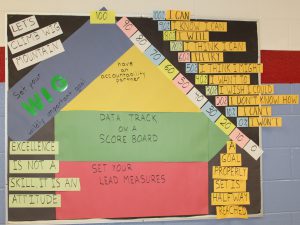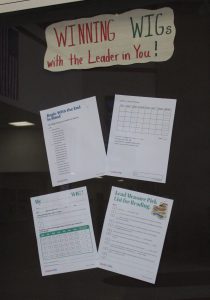Goals are more powerful than wishes
How Liberty schools use goal-setting for improvement
A wish is something we hope happens. A goal is something we make happen. The main difference between wishes and goals are: clear purpose, effort and priority.
Goal-setting is an integral part of the Leader in Me program, which Liberty has instituted in all of its buildings.
This year, elementary and middle school students have begun setting Wildly Important Goals, or WIGs. SMART goals have been a feature at the high school level for several years. In each case, these goals are those determined to be more important than all others. They are specific, measurable and realistic and can be personal or academic.
But setting the goal is only the first step.
Once a goal is identified, action steps are planned to help reach that goal.
For example, an elementary student’s WIG may be to read a chapter book each month. The student decides that goal can be achieved by reading 20 minutes each night. That task, known as a lead measure, can be used to track progress each day. This is habit building.
At the elementary school, goals can be academic, behavioral or social, and generally focus on the individual student. Although the goal may be personalized, the progress is shared with a partner, group, class or building. At LES, there are school-wide, classroom and individual student goals.

Sharing your progress toward a goal is important, according to LES Principal Robert England. “Letting your accountability partners know how you are doing is key. When students know that other people are invested in their daily progress, students are more likely to change their behaviors to achieve their goals. Eventually, these healthy behaviors turn into self-sustaining habits for long term wellness.”
At the middle school, the WIG starts at the building level: ”By May 2023, 80% of grade 5-8 students’ current Student Growth Percentile will be at or above proficiency level (25+) as evidenced by the Spring 2023 STAR Assessment in Reading.”
Each student’s goal is set using the STAR assessment given at the beginning of the year. The assessment breaks down each student’s progress and offers areas on which a student can improve. The students set their WIGs and list at least two things (lead measures) that can be used to help them reach that goal, such as taking notes during daily reading or effectively logging their reading time. Students will be reviewing their new STAR Assessment data from this winter to update their WIGs and Lead Measures.
A t LMS, time is set aside during classes to focus on the individual WIGs, and the teachers track the time spent. The time spent is compiled by grade on a google form. The tracking also makes it more fun for students, there is a schoolwide scoreboard displayed in the lobby and grade levels are celebrated at the monthly LIM DEAL (Leader in Me Drop Everything and Lead) Assemblies, said LMS Principal Heather Cheh.
t LMS, time is set aside during classes to focus on the individual WIGs, and the teachers track the time spent. The time spent is compiled by grade on a google form. The tracking also makes it more fun for students, there is a schoolwide scoreboard displayed in the lobby and grade levels are celebrated at the monthly LIM DEAL (Leader in Me Drop Everything and Lead) Assemblies, said LMS Principal Heather Cheh.
At the high school level, goal-setting is done slightly differently, using Specific, Measureable, Attainable, Relevant, Time Bound goals, which encompass the same dynamics of WIGs.
The high school has been using SMART goals since the Professional Learning Community model was introduced a few years ago. Each Content Teacher Team, those who teach the same course, has a SMART goal. Tracking progress is specific to each goal, but is accomplished through common assessments and data analysis.
Each level of goal-setting builds on the others.
When students do better, classrooms do better, then grade-levels do better, and the building does better, and eventually the district, as a whole, will see improvement.
These improvements could be academic, behavioral or social. Improvement in all three helps make for a better community schoolwide.

